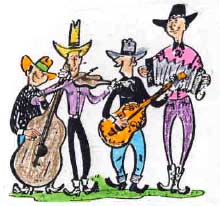|

This story was published in Radio Recall, the journal of the Metropolitan Washington Old-Time Radio Club, published six times per year.
Click here to return to the index of selected articles.
|
|
 Hey Kids, What Time Is It? Hey Kids, What Time Is It?
(Not What You're Thinking...)
A book review by Jim Cox
(From Radio Recall, February 2008)
The WBT Briarhoppers
Eight Decades of a Bluegrass Band
Made for Radio
by Tom Warlick and Lucy Warlick
Foreword by Robert Inman
53 photos, 215 pp. softcover
McFarland 2008
www.mcfarlandpub.com or 800-253-2187
At precisely 4:30 every weekday afternoon in Charlotte, North Carolina from the 1930s to the 1950s, an announcer stepped before a WBT microphone and pondered: "Do y'all know what hit is?"
"No!" in unison replied a group of male voices.
"Hit's Briarhopper Time!" the announcer shouted.
A string band struck up a rousing refrain of "Wait Till the Sun Shines, Nellie," the Briarhoppers' signature theme.
Another half-hour of fun and frolics was beamed across the ether wherever WBT's big 50,000-watt stick was pointed, easily blanketing the two Carolinas, some of Georgia, Tennessee, Virginia, West Virginia and Kentucky. The radio show, an institution along the Eastern Seaboard, was amplified by thousands of personal appearances, more than 500 country music recordings on Decca, RCA and other major labels, and perpetuated by WBTV when it signed on in 1949 as the Carolinas' first television outlet.
This is documented in a new soft-cover volume by Thomas and Lucy Warlick, The WBT Briarhoppers: Eight Decades of a Bluegrass Band Made for Radio. It's a compelling account of the effects of a string band that became synonymous with one station in a medium-sized market on its city and region as well as its greater implications on country music as a species.
There was a time that Charlotte amassed so many pickers and singers and had so many major recording studios within its environs that-with a little persistence-it could have challenged Nashville for honors as "Music City, U. S. A." By 1938, more than 30 mountain bands streamed into the city and took up permanent residence. But alas, in the early 1950s, station officials at WBT turned toward other pursuits. They were convinced that a more sophisticated culture was the chief desire of the listening audience. As a result, they relinquished an opportunity for continued dominance in country music broadcasting from Richmond to Miami.
That didn't banish the Briarhoppers forever, however. In fact, the authors reveal that there have been at least two resurgences of the original crew and their heirs. Late CBS newsman Charles Kuralt, an ex-WBT staffer, exclaimed: "The Briarhoppers were the Julliard String Quartet of country music and theirs was the music of my youth and upbringing in North Carolina. I thought that all music was played by guitar, banjo, fiddle, and bass, for that is pretty much all we ever heard on WBT."
Members of the troupe fluctuated frequently although some remained with it permanently. Stalwarts included Whitey and Hogan (Roy "Whitey" Grant, Arval Hogan), Don White, Hank Warren, Shannon Grayson, Fred Kirby, Claude Casey. Arthur "Guitar Boogie" Smith and the Crackerjacks along with George Hamilton IV and The Johnson Family Singers (including recording artist-radio singer Betty Johnson) were part of the WBT staff simultaneously. All of these legends of country and gospel music, however, operated outside the parameters of the Briarhoppers, suggesting that WBT was a beehive of live entertainment then. In the late 1930s and early 1940s the Carter Family was also with WBT (including Johnny Cash's future wife, June).
The Warlicks' greatest donation is possibly how a group like this came together, stayed together and perpetuated a form of rustic music that resonated not only with the rural people of the farms and hills but with many who had left those very places to move to Charlotte, Greensboro, Columbia, Greenville, Winston-Salem and other cities searching for better opportunities. These folks didn't abandon their roots, and the Briarhoppers reminded them of their sacred heritage in daily installments.
Unintentionally, it seems the authors provided a tell-all volume, too. Casually they reveal which Nashville superstar's illegitimate child (one we did not know about) was born in Charlotte while he was in town for personal appearances. We learned about a major Carolinas musician who was gay decades before it was popular to make such disclosures. When that made the local press, his services were terminated at WBT.
Carolina Hayride, Carolina Calling, The Johnson Family Singers, Grady Cole, Arthur Smith's Corner Store and other WBT-originated series frequently found themselves on the CBS network in the 1940s and 1950s. WBT was a CBS owned-and-operated station until 1945 and continued a powerhouse for the chain in that territory. This is a study encompassing more than music and musicians, reflecting how one outlet completely dominated the landscape.
The Warlick book is a delightful read for anyone following the Saturday night barn dances and folk musicians emanating from the hollows and hills of an earlier America, especially those finding a station like WBT to perpetuate it. It's a comprehensive summary of what happened in one place that was most likely repeated elsewhere across the nation in a handful of regional markets.
|